2022年中考英语二轮复习情态动词课件(共有PPT21张)
文档属性
| 名称 | 2022年中考英语二轮复习情态动词课件(共有PPT21张) | 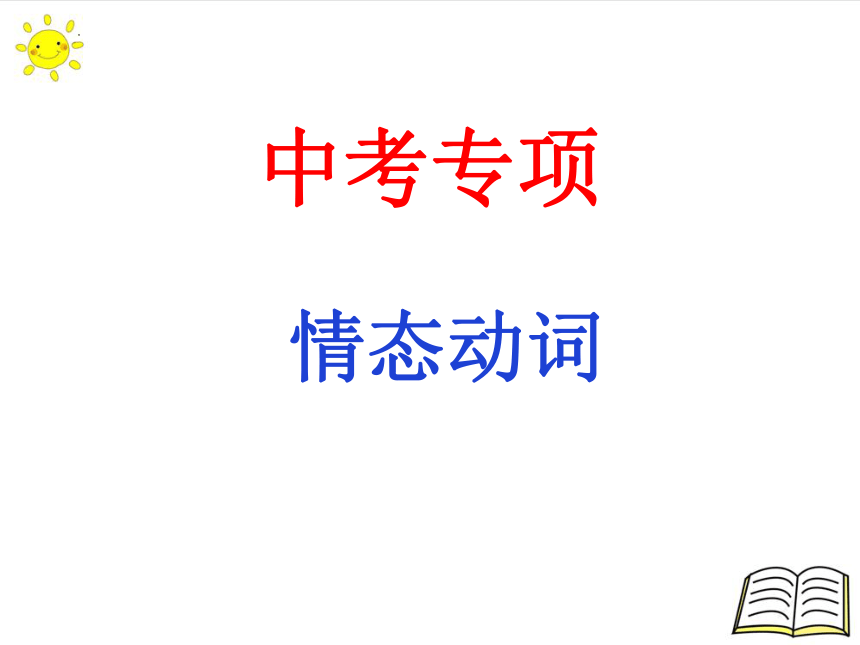 | |
| 格式 | pptx | ||
| 文件大小 | 155.8KB | ||
| 资源类型 | 教案 | ||
| 版本资源 | 通用版 | ||
| 科目 | 英语 | ||
| 更新时间 | 2022-04-26 11:16:36 | ||
图片预览

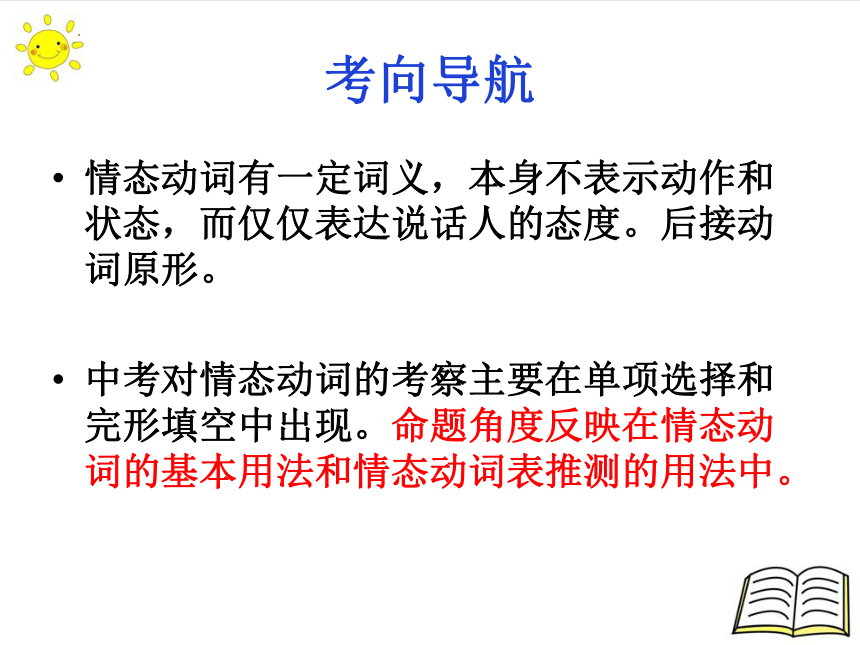
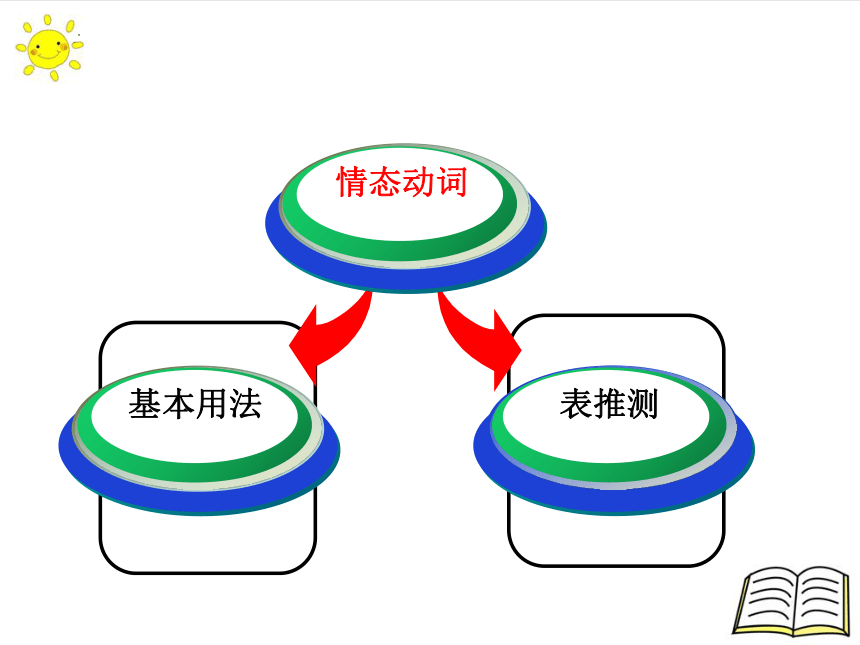
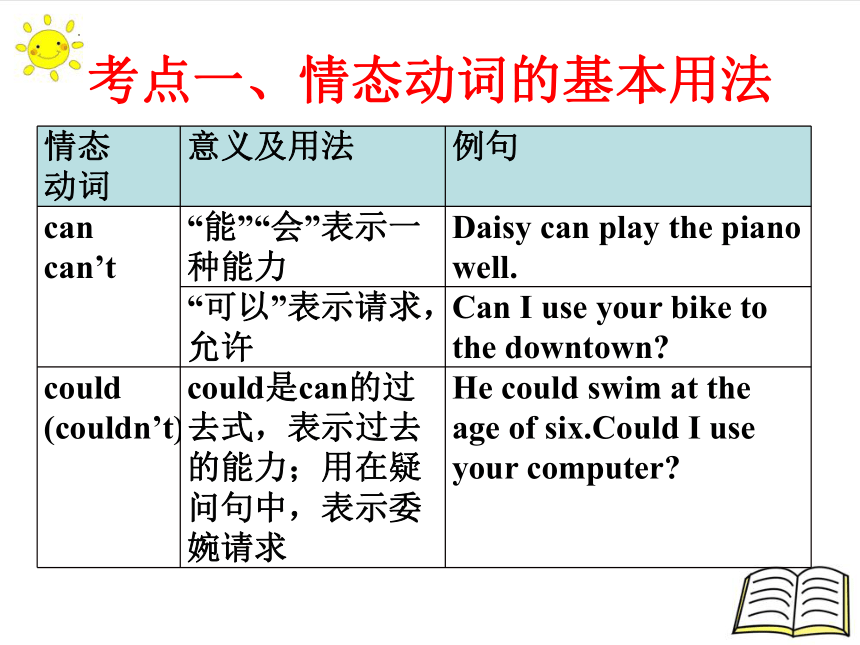
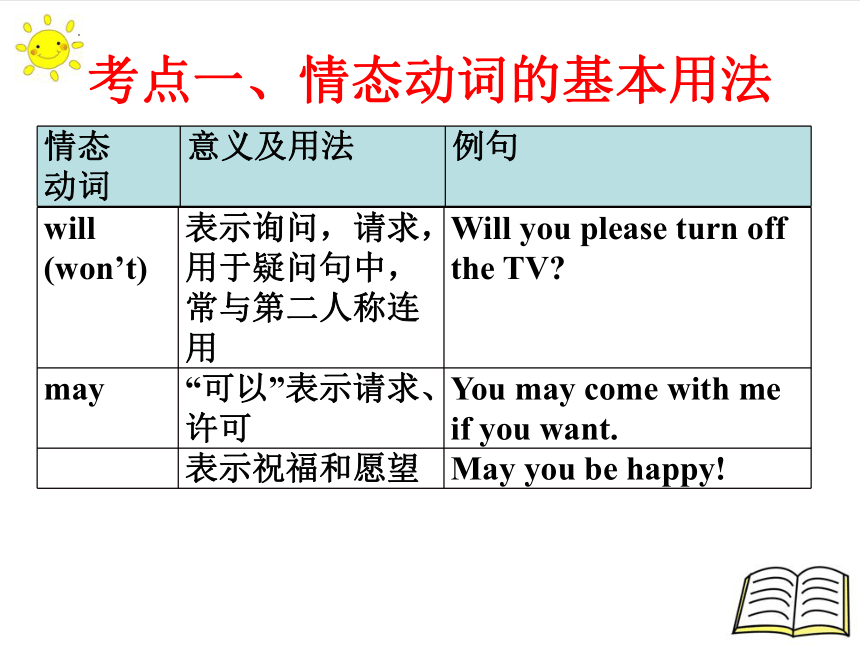
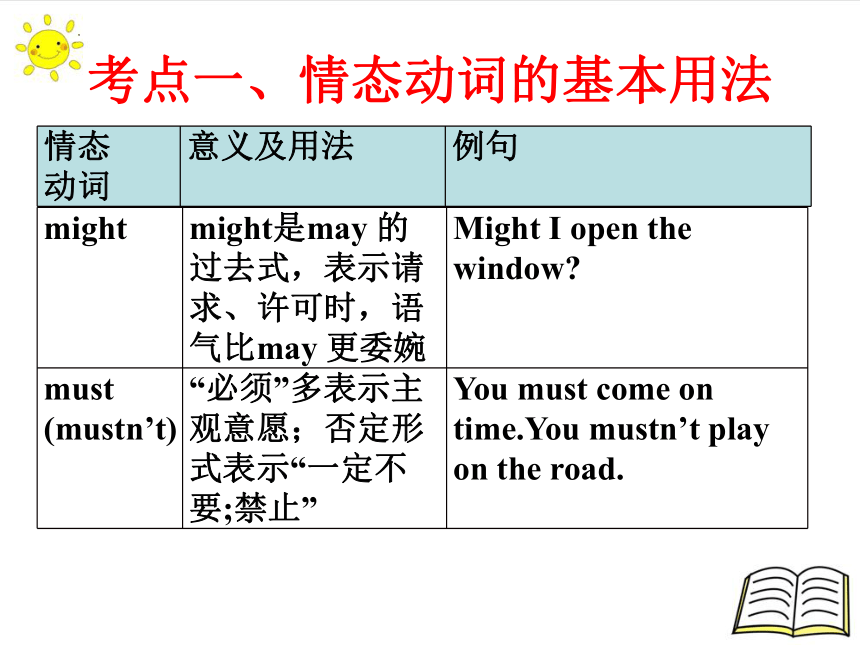
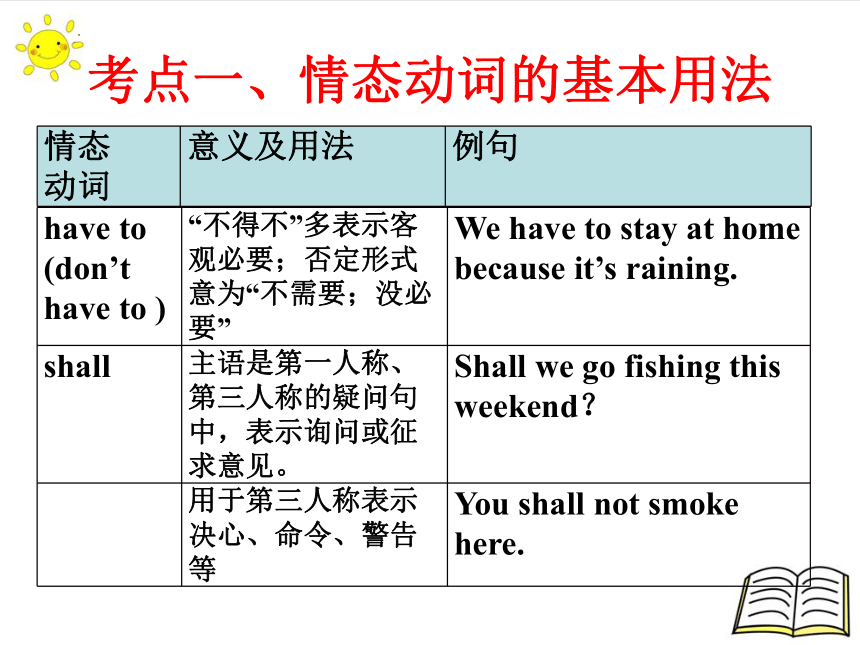

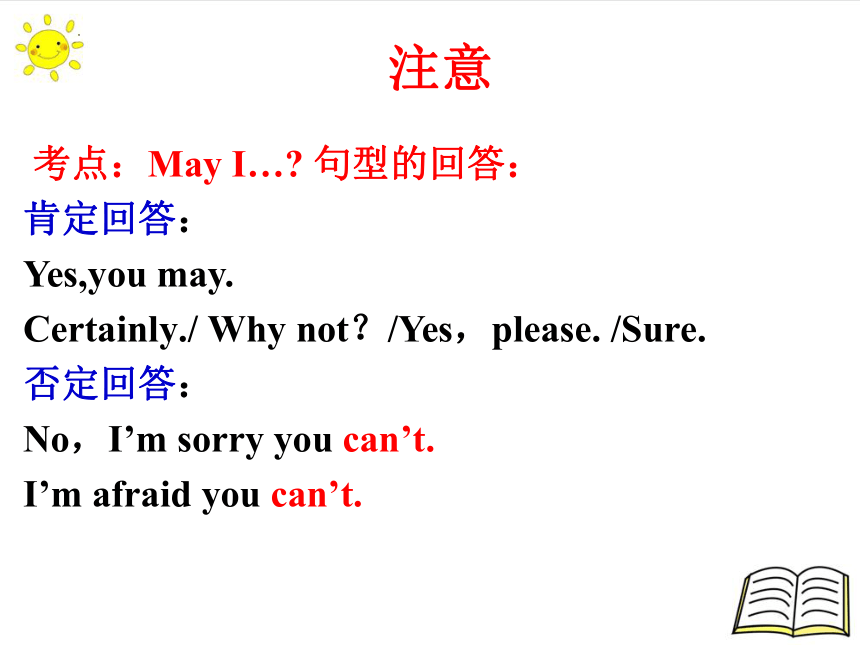
文档简介
(共21张PPT)
中考专项
情态动词
考向导航
情态动词有一定词义,本身不表示动作和状态,而仅仅表达说话人的态度。后接动词原形。
中考对情态动词的考察主要在单项选择和完形填空中出现。命题角度反映在情态动词的基本用法和情态动词表推测的用法中。
the
any
情态动词
基本用法
表推测
考点一、情态动词的基本用法
情态 动词 意义及用法 例句
can can’t “能”“会”表示一种能力 Daisy can play the piano well.
“可以”表示请求,允许 Can I use your bike to the downtown
could (couldn’t) could是can的过去式,表示过去的能力;用在疑问句中,表示委婉请求 He could swim at the age of six.Could I use your computer
考点一、情态动词的基本用法
will (won’t) 表示询问,请求,用于疑问句中,常与第二人称连用 Will you please turn off the TV
may “可以”表示请求、许可 You may come with me if you want.
表示祝福和愿望 May you be happy!
情态 动词 意义及用法 例句
考点一、情态动词的基本用法
might might是may 的过去式,表示请求、许可时,语气比may 更委婉 Might I open the window
must (mustn’t) “必须”多表示主观意愿;否定形式表示“一定不要;禁止” You must come on time.You mustn’t play on the road.
情态 动词 意义及用法 例句
考点一、情态动词的基本用法
have to (don’t have to ) “不得不”多表示客观必要;否定形式意为“不需要;没必要” We have to stay at home because it’s raining.
shall 主语是第一人称、第三人称的疑问句中,表示询问或征求意见。 Shall we go fishing this weekend?
用于第三人称表示决心、命令、警告等 You shall not smoke here.
情态 动词 意义及用法 例句
考点一、情态动词的基本用法
should (shouldn’t) ought to “(不)应该”表示责任和义务;也可以表示劝告或建议;表示征询意见,常用于疑问句 We should clean the classroom every day.
You ought to teach them carefully.
need (needn’t) “(不)需要”主要用于否定句和疑问句 You needn’t do that again.
had better “最好” 否定形式 had better not You’d better come here earlier.
情态 动词 意义及用法 例句
注意
考点:May I… 句型的回答:
肯定回答:
Yes,you may.
Certainly./ Why not?/Yes,please. /Sure.
否定回答:
No,I’m sorry you can’t.
I’m afraid you can’t.
注意
用于must的开头的一般疑问句的否定回答。
Must I go to school tomorrow
Yes, you must.
No, you needn't/don’t have to .
must
can’t
may/might
/could
100%
一定…
20%~80%
可能…
0%
一定不…
考点二、情态动词表推测
考点二、情态动词表推测
典型结构 1(必考点):
must be 一定是
can’t be 一定不是
The man in black can’t be Mr.Li.
He has gone to Beijing.
The book must be Lucy’s, for I can see her
name on the cover.
典型结构 2
情态动词+have +been,表示对过去的情况进行推测。
must have been (过去)一定是
can’t have been (过去)一定不是
I can’t have been late yesterday.
考点二、情态动词表推测
考点二、情态动词表推测
典型结构 3
情态动词+be doing,
表示对现在正在进行的情况进行推测。
must be +v-ing 一直在…
can’t be +v-ing 不可正在…
She must be sleeping.
She can’t be reading.
1.be able to & can
be able to+动词原形,可用多个时态
“能够” 强调经过努力而获得的能力
一般现在时: am/is/are able to
一般过去时: was/were able to
一般将来时:will be able to
现在完成时:have/has been able to
can 强调自身具备的能力,过去式could
考点三、结构辨析
2.have to & must
must“必须” ,情态动词,后接动词原形,
表示主观上认为必须做某事。
have to +动词原形,表示(客观条件下)不得不
做某事
I must study hard. 我必须努力学习。
(我觉得有必要这么做。)
I have to study hard. 我不得不努力学习。
(客观环境下不得不这么做)
考点三、结构辨析
经典真题
(2021北京中考)—Sam, ________ I join you in the community service
—Of course you can.
A. can B. must C. should D. need
【答案】A
经典真题
(2021 福建中考)According to the new regulation(规定), school students _________ take their cell phones to the classroom.
A. wouldn't
B. needn't
C. mustn't
【答案】C
经典真题
(2021 黑龙江牡丹江中考)There is no light on.They _______ be at home.
A. mustn’t
B. can’t
C. needn’t
【答案】B
经典真题
(2021 江苏南通中考)—Must I return this book before Friday, Sir
—No, you ________, dear. You can keep it for two weeks.
A. can’t B. shouldn’t
C. mustn’t D. needn’t
【答案】D
经典真题
(2021 山东菏泽中考)— I wonder if these are Jim’s glasses.
— They ________ be his. He doesn’t wear glasses.
A. could B. must C. can’t
【答案】C
中考专项
情态动词
考向导航
情态动词有一定词义,本身不表示动作和状态,而仅仅表达说话人的态度。后接动词原形。
中考对情态动词的考察主要在单项选择和完形填空中出现。命题角度反映在情态动词的基本用法和情态动词表推测的用法中。
the
any
情态动词
基本用法
表推测
考点一、情态动词的基本用法
情态 动词 意义及用法 例句
can can’t “能”“会”表示一种能力 Daisy can play the piano well.
“可以”表示请求,允许 Can I use your bike to the downtown
could (couldn’t) could是can的过去式,表示过去的能力;用在疑问句中,表示委婉请求 He could swim at the age of six.Could I use your computer
考点一、情态动词的基本用法
will (won’t) 表示询问,请求,用于疑问句中,常与第二人称连用 Will you please turn off the TV
may “可以”表示请求、许可 You may come with me if you want.
表示祝福和愿望 May you be happy!
情态 动词 意义及用法 例句
考点一、情态动词的基本用法
might might是may 的过去式,表示请求、许可时,语气比may 更委婉 Might I open the window
must (mustn’t) “必须”多表示主观意愿;否定形式表示“一定不要;禁止” You must come on time.You mustn’t play on the road.
情态 动词 意义及用法 例句
考点一、情态动词的基本用法
have to (don’t have to ) “不得不”多表示客观必要;否定形式意为“不需要;没必要” We have to stay at home because it’s raining.
shall 主语是第一人称、第三人称的疑问句中,表示询问或征求意见。 Shall we go fishing this weekend?
用于第三人称表示决心、命令、警告等 You shall not smoke here.
情态 动词 意义及用法 例句
考点一、情态动词的基本用法
should (shouldn’t) ought to “(不)应该”表示责任和义务;也可以表示劝告或建议;表示征询意见,常用于疑问句 We should clean the classroom every day.
You ought to teach them carefully.
need (needn’t) “(不)需要”主要用于否定句和疑问句 You needn’t do that again.
had better “最好” 否定形式 had better not You’d better come here earlier.
情态 动词 意义及用法 例句
注意
考点:May I… 句型的回答:
肯定回答:
Yes,you may.
Certainly./ Why not?/Yes,please. /Sure.
否定回答:
No,I’m sorry you can’t.
I’m afraid you can’t.
注意
用于must的开头的一般疑问句的否定回答。
Must I go to school tomorrow
Yes, you must.
No, you needn't/don’t have to .
must
can’t
may/might
/could
100%
一定…
20%~80%
可能…
0%
一定不…
考点二、情态动词表推测
考点二、情态动词表推测
典型结构 1(必考点):
must be 一定是
can’t be 一定不是
The man in black can’t be Mr.Li.
He has gone to Beijing.
The book must be Lucy’s, for I can see her
name on the cover.
典型结构 2
情态动词+have +been,表示对过去的情况进行推测。
must have been (过去)一定是
can’t have been (过去)一定不是
I can’t have been late yesterday.
考点二、情态动词表推测
考点二、情态动词表推测
典型结构 3
情态动词+be doing,
表示对现在正在进行的情况进行推测。
must be +v-ing 一直在…
can’t be +v-ing 不可正在…
She must be sleeping.
She can’t be reading.
1.be able to & can
be able to+动词原形,可用多个时态
“能够” 强调经过努力而获得的能力
一般现在时: am/is/are able to
一般过去时: was/were able to
一般将来时:will be able to
现在完成时:have/has been able to
can 强调自身具备的能力,过去式could
考点三、结构辨析
2.have to & must
must“必须” ,情态动词,后接动词原形,
表示主观上认为必须做某事。
have to +动词原形,表示(客观条件下)不得不
做某事
I must study hard. 我必须努力学习。
(我觉得有必要这么做。)
I have to study hard. 我不得不努力学习。
(客观环境下不得不这么做)
考点三、结构辨析
经典真题
(2021北京中考)—Sam, ________ I join you in the community service
—Of course you can.
A. can B. must C. should D. need
【答案】A
经典真题
(2021 福建中考)According to the new regulation(规定), school students _________ take their cell phones to the classroom.
A. wouldn't
B. needn't
C. mustn't
【答案】C
经典真题
(2021 黑龙江牡丹江中考)There is no light on.They _______ be at home.
A. mustn’t
B. can’t
C. needn’t
【答案】B
经典真题
(2021 江苏南通中考)—Must I return this book before Friday, Sir
—No, you ________, dear. You can keep it for two weeks.
A. can’t B. shouldn’t
C. mustn’t D. needn’t
【答案】D
经典真题
(2021 山东菏泽中考)— I wonder if these are Jim’s glasses.
— They ________ be his. He doesn’t wear glasses.
A. could B. must C. can’t
【答案】C
同课章节目录
- 词法
- 名词
- 动词和动词短语
- 动词语态
- 动词时态
- 助动词和情态动词
- 非谓语动词
- 冠词
- 代词
- 数词和量词
- 形容词副词及其比较等级
- 介词和介词短语
- 连词和感叹词
- 构词法
- 相似、相近词比较
- 句法
- 陈述句
- 一般疑问句和否定疑问句
- 特殊疑问句及选择疑问句
- 反意疑问句
- 存在句(There be句型)
- 宾语从句
- 定语从句
- 状语从句
- 主谓一致问题
- 简单句
- 并列句
- 复合句
- 主谓一致
- 主、表语从句
- 名词性从句
- 直接引语和间接引语
- 虚拟语气
- 感叹句
- 强调句
- 倒装句
- 祈使句
- 句子的成分
- 句子的分类
- 题型专区
- 单项选择部分
- 易错题
- 完形填空
- 阅读理解
- 词汇练习
- 听说训练
- 句型转换
- 补全对话
- 短文改错
- 翻译
- 书面表达
- 任务型阅读
- 语法填空
- 其他资料
